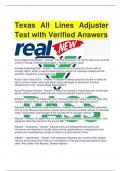WGU Computer
Architecture Exam
Questions and Complete
Solutions Graded A+
Denning [Date] [Course title]
,Personal Computer(PC) - Answer: A computer designed for use by an individual, usually incorporating a
graphics display, a keyboard, and a mouse
Server - Answer: A computer used for running larger programs for multiple users, often simultaneously,
and typically accessed only via a network
Supercomputer - Answer: A class of computers with the highest performance and cost; they are
configured as servers and typically cost tens to hundreds of millions of dollars
Embedded computer - Answer: A computer inside another device used for running one predetermined
application or collection of software.
Personal mobile devices(PMDs) - Answer: Are small wireless devices to connect to the internet; they rely
on batteries for power, and software is installed by downloading apps. Conventional examples are smart
phones and tables
Cloud computing - Answer: refers to large collections of servers that provide services over the internet;
some providers rent dynamically varying numbers of servers as a utility
Software as a Service (SaaS) - Answer: delivers software and data as a service over the internet, usually
via a thin program such as a browser that runs on local client devices, instead of binary code that must
be installed, and runs wholly on that device. Examples include web search and social networking
Acronym - Answer: A word constructed by taking the initial letters of a string of words. For example:
RAM is an acronym for Random Access Memory, and CPU is an acronym for Central Processing Unit
Terabyte(TB) - Answer: Originally 1,099,511,627,776(2^40) bytes, although communications and
secondary storage systems developers started using the term to mean 1,000,000,000,000(10^12) bytes.
To reduce confusion, we now use the term
tebibyte(TiB) - Answer: for 2^40 bytes
Moore's Law - Answer: States that integrated circuit resources double every 18-24 months
,Abstraction to Simplify Design - Answer: Used to characterize the design at different levels of
representation; lower-level details are hidden to offer a simpler model at higher levels
Common Case Fast - Answer: Will tend to enhance performance better than optimizing the rare case.
Performance via parallelism - Answer: Since the dawn of computing, computer architects have offered
designs that get more performance by computer operations in parallel
Pipelining - Answer: Moves multiple operations through hardware units that each do a piece of an
operation, akin to water flowing through a pipeline
Prediction - Answer: In some cases it can be faster on average to guess the start working rather than
wait until you know for sure, assuming that the mechanism to recover from a misprediction is not too
expensive and your prediction is relatively accurate.
Hierarchy of Memories - Answer: This is used to address conflicting demands of fast, large, and cheap
memory with the fastest, smallest, and most expensive memory per bit at the top of the hierarchy and
the slowest, largest, and cheapest per bit at the bottom.
Dependability via Redundancy - Answer: We make systems Dependable by including redundant
components that can take over when a failure occurs.
System Software - Answer: Software that provides services that are commonly useful, including
operating systems, compilers, loaders, and assemblers
Operating system - Answer: Supervising program that manages the resources of a computer for the
benefit of the programs that run on that computer
Compiler - Answer: A program that translates high-level language statements into assembly language
statements
Instruction - Answer: A command that computer hardware understands and obeys
, Assembler - Answer: A program that translates a symbolic version of instructions into the binary version
High-level programming language - Answer: A portable language such as C, C++, Java, or Visual Basic that
is composed of words and algebraic notation that can be translated by a compiler into assembly
language
Input device - Answer: A mechanism through which the computer is fed information, such as a keyboard
Output device - Answer: A mechanism that conveys the result of a computation to a user, such as a
display, or to another computer
Liquid crystal display - Answer: A display technology using a thin layer of liquid polymers that can be
used to transmit or block light according to whether a change is applied
Active matrix display - Answer: A liquid crystal display using a transistor to control the transmission of
light at each individual pixel
pixel - Answer: The smallest individual picture element. Screens are composed of hundreds of thousands
to millions of pixels, organized in a matrix
Integrated circuit - Answer: Also called a chip. A device combining dozens to millions of transistors
Central Processor unity(CPU) - Answer: Also called processor. The active part of the computer, which
contains the datapath and control and which adds numbers, tests numbers, signals I/O devices to
activate, and so on
Datapath - Answer: The component of the processor that performs arithmetic operations
Control - Answer: The component of the processor that commands the datapath, memory, and I/O
devices according to the instructions of the program



